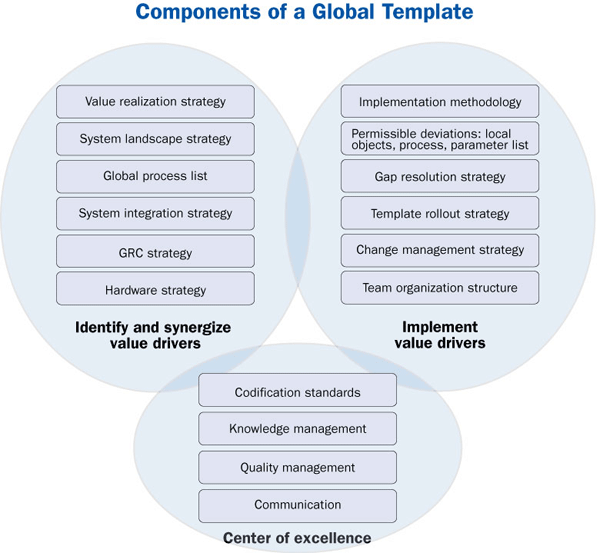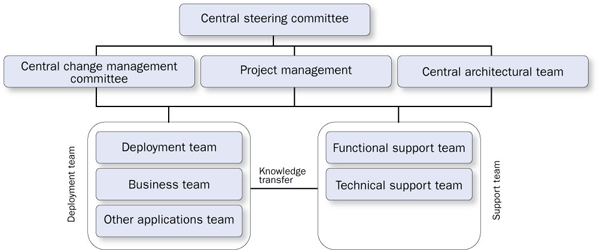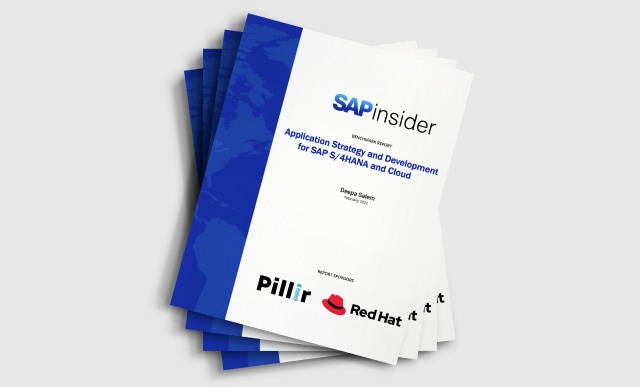Discover the components of a global template and the advantages of implementing it across an enterprise.
Key Concept
A global template is a common approach and solution across geographies and markets. A global template formulates the strategy for business processes, system architecture, implementation methodology, change management, hardware, and value realization. The global template typically consists of identifying, synergizing, and implementing value drivers across the organization. The center of excellence offers support for the identification and implementation of value drivers.
SAP implementations are typically focused on addressing the value perceived at a point in time. However, with rapid changes in the market due to globalization, advancements in the technology sector, and changes in the way supply chains are managed, many enterprises redefined their manufacturing, sourcing, and distribution strategies. Though this transition brought substantial value to organizations, it also introduced complexities within the process and the system landscape. Now when enterprises look into their rearview mirror, they may realize that they have a pool of complex processes running across various systems or countries. More importantly, they may notice that they lack an important factor: synergy.
You can achieve this sought-after synergy by setting up a common framework for processes, systems, structure, and data across the enterprise and around the globe. This common framework is called a global template. This article is useful for enterprises that have multiple manufacturing and distribution facilities within a country or across the globe, and for enterprises with a vision of common processes and governance standards across their organization.
I’ll start by explaining what a global template is. Next I’ll move on to identifying and synergizing value drivers, and then reviewing value realization, system landscape, global process list, system integration, GRC, and hardware strategies. After that, I’ll share some information about implementing value drivers, including methods for implementations, rollouts, deviations, gap resolution, change management, and team structure. I’ll consider a center of excellence based on codification standards, knowledge management, and quality management to ensure the quality of the implementation. Finally, I’ll close with the key benefits to following a global template approach.
A Global Template and Its Components
A global template establishes guidelines across various functions, systems, structures, processes, and data. Key stakeholders within the organization agree on these guidelines. The global template approach evaluates all the processes across regions and markets and chooses the best process after considering the industry best practices, process merits, and deployability across regions and markets. A global template offers a strategic common view to manage all the functions, systems, structures, processes, and data.
You can see the key components of a global template in
Figure 1.

Figure 1
Components of a global template
Identify and Synergize Value Drivers
You should begin the process by identifying value drivers and finding ways to achieve synergy among them. A good SAP global template solution uses strategies involving:
- Value realization
- System landscape
- Global process list
- System integration
- GRC
- Hardware standardization
Value Realization
Though global template programs make a good business case for ROI, it is very important that value realization remain the focus throughout the project. It is essential to decide how the value benefits will be captured, quantified, and tracked at a process level.
System Landscape
A system landscape strategy categorizes the applications as core and non-core after a detailed analysis of the applications and the interfaces connecting these applications.
The core applications form the backbone of the entire system landscape. For example, all SAP applications are typically part of the core applications list. The core applications have strategic importance and offer higher value and stability. Core applications are generally irreplaceable. They may offer best-in-class or unique services, or perhaps modifying them does not justify the investment that it would require.
Non-core applications provide services that can be replaced by core applications. Alternatively, these non-core application functions may not be needed after business process re-engineering. Non-core applications are generally non-strategic from a business or technology perspective. For example, many companies run homegrown applications for managing some of their business processes in manufacturing, quality control, warehousing, or customer interaction. These applications are loosely connected to core applications. As time passes, these applications attract substantial maintenance costs and lack solution leadership. If replaced, these applications have a low-to-medium change management impact.
The system landscape strategy must be supported by a system realization strategy. It consists of a rough time frame in which the targeted non-core applications are rationalized. The system rationalization strategy requires highly precise inputs on change management impact, cost-saving potential from rationalizing the applications, and an envisaged to-be system. ROI is greatly influenced by the system landscape strategy.
A typical global template’s system rationalization strategy is formulated as below:
- Identify the core processes
- List the applications supporting the process across markets or regions
- Evaluate the existing applications on key parameters such as product leadership, long-term strategic value, annual cost of maintenance, and what the change management impact would be if you were to replace the strategy
- Identify the other options and evaluate them on the above parameters
- Finalize the business case to evaluate the cost-benefit analysis
- Finalize the rationalization plan
Global Process List
A global process list is the list of processes and subprocesses that offer great value by standardization. This standardized solution is developed by the key stakeholders from various teams, such as business, IT, and partners. These processes are listed and documented in detail, along with the agreed-upon business rules and permissible deviations. When deciding on a global process, inputs are taken from all regions and markets and these processes are then compared.
The global process list gathers all the common processes followed across the globe and thus offers significant help for new deployments. You can append or modify this list only after the change request gets an approval from the central architecture team and the change control committee. These teams are the backbone of the global template project, and they are authorized to maintain and enrich the global template.
The global process list is a live document that is updated when any change is implemented. This helps the maintenance team know the latest process version and the associated functional and technical documentations.
It is often one of the first documents consulted when a new deployment is commissioned. The processes at new deployment sites are compared to the processes established in a global template’s global process list. Processes that don’t fit with the global process list are referred to as gaps. These gaps then become additional permissible deviations or are referred to as local requirements. The local requirements are then referred to a change control committee and central architecture committee for further action.
System Integration
A system integration strategy mainly focuses on integrating multiple systems or applications. It focuses on the choice of the middleware or enterprise application integration (EAI) tools to be used. System integration is often a critical strategy with long-term implications. This strategy also supports electronic data interchange (EDI) requirements (e.g., field mapping) of the organizations.
GRC
Although every country has specific governance and compliance requirements, most of the requirements refer to common governance principles such as segregation of duties (SoD). Setting up common guidelines across the organization — instead of carrying out certain exercises repeatedly for every deployment — saves a substantial amount of effort and cost. The global template may also contain matrices based on organization-wide guidelines for SoD for the business role against allowed system transactions. For example, SoD guidelines provide a universal principle that the person responsible for purchase order (PO) creation should not be authorized for purchase price maintenance.
The role matrix defined in a global template ensures that the role containing SAP transactions for PO creation does not include the transactions for purchase price maintenance. Instead the global template defines two separate roles for PO maintenance and purchase price maintenance. During deployments, the deployment teams only assign the role (i.e., profile) to the user. This ensures compliance to the organization-wide governance mechanism and that the governance model is not reinvented at each site. After you set up the matrices, each deployment assigns the users to their roles.
The consolidated governance models establish common mechanisms to implement policies and business rules. For example, the governance policies can define the set of acceptable guidelines for credit management. Each market or region can choose a pre-approved credit policy that is suitable for their business. This mechanism ensures governance and provides enough flexibility for the business to perform its day-to-day tasks.
Hardware Standardization
When designing a global template for an enterprise with a global presence, it is often challenging to define the hardware strategy. For example, the choice of the printer might be critical for designing a global printing solution for complex fonts (e.g., bar code). If you don’t standardize hardware, the global solution might have limited reusability. The hardware strategy may also need to look at the sizing of the workstation, bar-code scanners, and radio frequency ID (RFID) guns.
Hardware strategy is also closely linked to system landscape strategy. It is a common practice to use handheld devices in the field. The system landscape considers the handheld an application, and it has to have a strategy defined for that application. Hardware standardization is often a challenging task due to the lack of availability of some hardware in certain regions. It’s important that you strategically source your hardware so that hardware standardization across the organization is achieved. The consolidated hardware often brings in cost advantages.
Implement Value Drivers
Next you need to implement value drivers. In doing so, you need to consider the following areas:
- Implementation methodology
- Permissible deviations and local requirements
- Gap resolution
- Template rollout
- Change management
- Team structure
Implementation Methodology
Implementation methodology refers to an approach for an SAP solution implementation. This typically includes the major project phases, activities within each of these phases, and milestones. Most SAP projects follow ASAP methodology, which includes project preparation, business process blueprinting, realization, go-live preparation, and go-live/support phases.
Standardizing the implementation methodology helps senior management monitor the progress with consistent milestones and parameters. A common approach also helps micro-level planning, including process approval stages and user acceptance testing, particularly when multiple rollout sites are deployed in parallel. The standardization of implementation methodology also helps to estimate efforts more accurately for future deployments.
Permissible Deviations and Local Requirements
The permissible deviation list is the list of processes or parameters required to accommodate the mandated local processes within a country or for a market. For example, a country or region may have very specific legally mandated documentation (content and format) requirements for export process documentation. Such mandated requirements can be part of the local requirement list.
To keep enough flexibility in the process, you need to adjust the process parameters. For example, an enterprise may have a global purchase order approval process. However, it is recommended that there be some flexibility for an individual purchasing organization to decide the approval limit that suits their individual governance guidelines.
Gap Resolution
A gap is a description of a process that is not consistent with the global template. The gap could arise due to the discovery of a process not considered in a global template before, or due to a deviation from a global template business rule over a period of time. The gap resolution strategy recommends various approaches that can be adopted to address the gap. Typical approaches, in preferred sequence, are:
- Redesign the process according to the standards established in the global template
- Suggest an alternate process available in the global template to replace the existing process
- Modify the global process to also align with the specific need after getting approval
To implement the gap resolution strategy successfully, you need to have a centralized change control committee and central architecture team that monitor any new change requested by the business users.
Template Rollout
The rollout strategy mainly focuses on defining the rollout sequence. Rollout sequence is critical because a well-planned rollout strategy may glean greater quantitative and qualitative benefits. The key inputs that go into a rollout strategy are the categorizations of markets, products, regions, language, and business priorities.
Change Management
A change management strategy includes managing change, identifying risks, and planning mitigations for the following:
- Internal partners: Mainly deals with addressing the change management issues among the business users. Such an issue might be to reduce the potential impact from the implementation of a new system. An enterprise may consider using an exhaustive training program before the implementation.
- External partners: Mainly deals with addressing the change management issues among external partners such as customers or suppliers. For example, if the project is going to modify the contents of the supplier portal, it may have a direct impact on the suppliers when they access the portal. You have to anticipate the scope of this impact in advance, and document and implement a strategy.
- Process: As the solution matures, some changes to the processes are inevitable. However, a strong change management process ensures that the change is consistent with the global guidelines.
The change management strategy needs to include the team structure responsible for managing the change, including predefined roles and responsibilities.
Team Organization Structure
You need to align team organization structure based on the specific needs of the project.
Figure 2 depicts one of the effective structures for team organization.

Figure 2
Team organization structure
Here is a description of the committees and teams shown in
Figure 2, along with their main responsibilities.
- Central steering committee: Steers the program as a whole. Additionally, an enterprise may have a local steering committee for deployments.
- Central change management committee: Devising and implementing the change management initiatives
- Project management office: Managing day-to-day project tasks
- Central architectural team: Designing, implementing, and supporting the global template
- Business team: The enterprise’s internal team that represents business or IT. This may include multiple key stakeholders within the organization.
- Other applications team: Supporting the various core and non-core applications. This team provides critical inputs when interfacing these applications.
- Deployment team: Implementing or deploying the global template. This team consists of the ERP solution deployment team, a team from the business, and teams from various other applications as needed.
- Support team: Day-to-day issue resolution. It consists of a functional team and the technical team.
A project may have several additional teams for documentation, quality, and communication.
Center of Excellence
The center of excellence typically includes the central processes that ensure adequate quality standards are maintained and followed. From a global design perspective, a center of excellence contains:
- Codification standards: The codification standards establish naming conventions for the various objects and documents used during the project life cycle. For example, you can use codification standards to define organizational entities in the SAP system. A plant code should be a four-character alphanumeric code, with the first two characters representing the country and next two digits representing the next available two-digit number. Setting up these standards avoids confusion within the deployment teams and helps maintain consistency in the system.
- Knowledge management: Using a global template, a substantial number of documents are generated at various stages of the project. Various documents, such as project plans, review meetings, presentations, process flow diagrams, functional and technical specifications, and test plans are reused and revisited multiple times. The prime objective of knowledge management is ease of retrieval and the reusability of the documents. A good knowledge management practice ensures that the documents are stored in the structured format at the predefined location on the Web site or within a directory structure.
- Quality processes: The quality process standards ensure that a project is executed with the desired quality standard
- Communication: Generally, global template projects are broadly staffed, with multiple players seeking a different level of information at different times. It is important to have a central communication Web portal that provides various levels of information to the readers.
Benefits with a Global Template Implementation
The typical benefits with the implementation of the global template are:
Reduction in Cost
Multiple processes across multiple systems require huge support and enhancement costs. The total cost of the ownership can be largely categorized into the human resource cost required to maintain or deploy the solution, the software license cost, and the hardware cost. There are four kinds of cost to keep an eye on:
- The human resource cost required to maintain or deploy the solution. The human resources can be further categorized into an enterprise’s own resources (e.g., the key business or IT users, system maintenance teams) and the solution deployment or maintenance team resources. Each application or set of processes demands specific skill sets. Thus, larger and more complex system landscapes may attract higher human resource costs. The standardized solution helps consolidate the resources and skill sets, reducing the cost. Also, a localized perspective for any enhancement tends to ignore the reusability aspect and this may lead to the duplication of enhancement and support efforts when a similar need arises in another region or market. The synergized global landscape focuses on the reusability of the processes. The global template approach improves standardization of processes and rationalization of the system landscape. By adopting a global template approach, an enterprise targets the core cost drivers rather than merely scratching the surface for cost reductions.
- The software licensing cost, on a larger level, which is proportional to the number of software licenses used within the landscape. This cost can be fixed or variable. The global template approach addresses this cost driver by putting the system rationalization strategy in place.
- The hardware cost, which is largely driven by the application used in the landscape, the extent of the use of the application, and the technical platform used by the application. Again, the system rationalization strategy aims at bringing this cost down.
- Cost of obsolescence, which is often hidden. Several applications implemented in the past may continue to work on the obsolete technical platform and may have failed to keep up with time or changes in the markets. Maintaining these applications is often challenging from a skill set availability perspective.
Scalability
In simple terms, scalability is how the process can be deployed in other markets or how it can be upgraded to a newer process. For example, many conventional implementations have enhancements that are local in nature, and thus these implementations lack the ability to deploy the process at different sites even though the overall process requirement is the same. The global template model approach is more standardized and thus is more scalable. Process reusability is an important factor when designing a global process.
Lower Solution Deployment Costs for Rollouts
With more standardized processes and business rules documented and accepted by the larger business community, the rollout project time lines can be reduced considerably. Typically, the cost of blueprinting and realization are diminished significantly during rollouts.
Higher Governance and Compliance
With organizations adhering to tougher governance guidelines such as Sarbanes-Oxley, it’s important to have common governance guidelines set up across the organization to avoid separately reinventing the governance model at each site. A globally integrated GRC model improves compliance and reduces the redundancy of efforts spent on making an organization process- and/or system-compliant in every different location. A centralized governance design can control local governance process deviations more effectively.
Sameer Page
Sameer Page has more than 15 years of experience in supply chain management and information technology, with more than ten years in SAP program management and SAP consultancy. He has extensive knowledge of the tools and methodologies associated with a global template program, with vast experience across multiple industry verticals and geographies. His major strengths are in program management. He has proven analytical, organizational, and problem-solving skills that are complemented by the ability to communicate effectively with diverse teams and key stakeholders.
If you have any comments about this article or SAP Professional Journal, or want to submit an idea for an article, contact
the SAP Professional Journal editor Scott Priest.
You may contact the author at
sameerpage@gmail.com.
If you have comments about this article or publication, or would like to submit an article idea, please contact the
editor.









